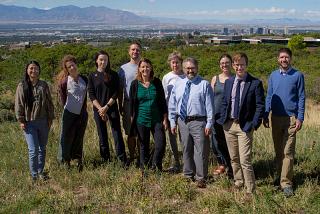Breadcrumb
Utah ranks among the top 10 states for suicide death. Despite great strides in treatment of mental illness, suicide rates have increased over the past two decades.
By focusing on genetic inheritance, Hilary Coon, PhD, Principal Investigator for the Utah Suicide Genetics Research Study (USGRS) and her research group hope to untangle the contradictions and learn to better predict and prevent suicide death, detect and intervene earlier, and develop targeted treatments. But that raises a question: Can risk of death by suicide actually be inherited?
Research involving twins and adopted children helped confirm that genetics contribute about 50 percent to suicide death risk. Still, many genetic variants likely play a role. “Many human traits have a significant genetic component,” says Coon. “But unlike Huntington’s disease, which is caused by a single gene, suicide is complicated.”
“We’re making progress on predicting suicide attempts. But suicide death is not just an extension of suicide attempts—and predictive validity of suicide death is still about zero.”
Hilary Coon, PhD, Principal Investigator, Utah Suicide Genetics Research Study (USGRS)
Rich Resources
The USGRS focuses on understanding the underlying genetic risks that result in different vulnerabilities to illness, stressors, and environmental exposure. Given the many possible genetic variants, researchers need large sample sizes.
HMHI has a unique combination of resources to study suicide death and fill this gap in research knowledge, starting with the Utah Population Database (UPDB). The extensive family histories at the core of the UPDB make it one of the few resources in the world with information in-depth enough to support research on genetics, epidemiology, demography, and public health.
In addition, a two-decade collaboration with the Utah Office of the Medical Examiner has enabled collection of biosamples, resulting in the largest collection of DNA samples in the world from individuals who died by suicide. This unprecedented collaboration began thanks to the efforts of Douglas Gray, MD, a pioneer in suicide prevention at University of Utah Health. The collection also includes hair samples, which can reveal exposures and/or substances ingested in the months before suicide death.
Partnerships with Intermountain Healthcare and University of Utah Health make comprehensive health care data available for about 85 percent of the individuals in the study. To protect the families’ privacy, samples and data are de-identified before the research team studies them.
Analyses show about 30 gene variants that could be implicated in suicide death. These are the first comprehensive genome-wide analyses of large samples taken over several decades from a broad population— rather than psychiatric patients only. The studies have been published in The American Journal of Psychiatry, Neuropsychiatric Genetics, and Molecular Psychiatry. Still, the lack of samples from persons not of European ancestry is a drawback. The researchers hope to increase diversity in race and ethnicity by working with colleagues in the United States and abroad.
“They say, ‘Keep working on this.’ Even if you save just one life, it’s worth it.”
Hilary Coon, PhD, Principal Investigator, Utah Suicide Genetics Research Study (USGRS)
21st–Century Roundtable
Collaborative approaches like the USGRS help accelerate research progress, Coon says. “We have this great resource, but our research community is even more important,” she continues. “It’s like a 21stcentury roundtable, where each investigator has a seat, and the table is the resource. We can expand to accommodate new and upcoming internal investigators and external collaborations.”
In this case, the Holy Grail of genetic disposition could make a life-and-death difference. Coon sometimes hears from people concerned about suicide death in their families and hopeful that research will help.
